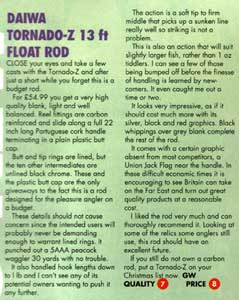What the manufacturer says –
Offering what can only be described as a breathtaking blank and action for such a low price tag.
Our Proteus match rods are designed around the simple principle of power progression. Offering a responsive tip action each rod loads further into its length delivering a progressive increase in power, with plenty of reaction to lunging fish and loads of cushion when striking into bigger encounters. Two lengths are offered at 13 and 14 with latter even handling 8lb main lines when called for.

Model Length Wgt Ozs Style Rec’d Lines lbs Guides RRP
PRM13W 13’ 7.4 Waggler 2-6 A/O* £54.99
PRM13P 13’ 8.4 Power 3-8 A/O* £54.99
PRM14P 14’ 9.1 Power 3-10 A/O* £54.99
*Aluminium Oxide
FEATURES
- Premium grade, high tensile carbon blank
- Reactive action with power progression
- Aluminium Oxide ceramic guides
- Duplon fore grip with a wind down reel seat
- Duplon rear grip
What the reviewer says –
It was interesting to get hold of one of these rods as they sit between the bucket-shop-bargain rods (which usually aren’t so much of a bargain) and the more serious rods for the keener and well advanced angler.
It is a nice blank, well ringed although apart from the bottom two, which are triple legged rings, all the remaining ones are single legged (as they’re known), but that is now par for the course on most match rods whatever the cost. The balance feels good and it has got quite a bit of power behind it, the action being tip to middle; bear in mind that this is just the waggler and not the power version. You could hold this rod, with reel, for quite a long time without tiring, which isn’t bad for a rod retailing for just £54.99.
Now I have to bring in a blast from the past.


It’s 15 years ago, almost to the day (December 1994), that I tested a Daiwa Tornado 13ft match rod for Coarse Angler magazine (article and photo scanned for comparative and evidence purposes only and “GW” was supposed to be me) and that too retailed at £54.99. The Tornado was a breakthrough at that time being the first all carbon blank at such a low price, most others in that price bracket were of a composite construction or in other words, mostly fibre glass.
So what has changed in 15 years in a rod that is sold at exactly the same price? Well, the most obvious thing is that the Tornado was made in the UK and it sported a small Union Flag on the butt section above the handle. This Proteus is made in Daiwa’s own factory in China, but to the same high standards, I’m sure and even carbon has come on in leaps and bounds since 1994.
Secondly, the reel seat has changed because gone are the hideous two sliding rings that we used to have holding the reel in place and thank heavens for they frequently came apart and allowed the reel to fall off! I much prefer the present positive screw down reel seats with a Duplon fore-grip any day, far more comfortable.
Thirdly, the rings. Apart from now using single legged rings (the Tornado’s were four legged rings), these on the Proteus are all lined with aluminium oxide, the Tornado’s (apart from butt and tip) weren’t lined at all. To be fair, many budget rods at that time had unlined rings and Daiwa had to make economies somewhere to keep the price down. It’s for economy reasons why so many companies use single legged rings, it’s easier, quicker, and cheaper as there’s only one whipping, although some insist it’s to maintain the blank’s action. I’d still be prepared to pay a little extra for a few more triple legged rings, at least up the entire middle section.
The graphics on the Tornado were modest enough for their day, but on the Proteus they’re hardly noticeable at all. That’s OK by me, but some like the flash of colour and bright lettering, I’m probably old-fashioned. The Tornado had a complete quality cork handle, but the butt cap was a simple plastic one. On the Proteus the cork only runs from the reel seat to the Duplon butt grip, which is shaped as you find on many rods and totally acceptable.
I can’t remember the weight of the Tornado and didn’t record it in my review at that time, but I can only imagine it would have been a little heavier than the Proteus. I can tell you that the Proteus weighs in at exactly 8ozs, hardly the lightest of match rods, but you’d have to spend far, far more to take an ounce off.
My 10 year old Milo Lexia (costing £140 at the time) weighs just 6.2 ozs, but the handle is very thin (21mm) with an uncomfortable screw reel fitting. I much prefer the comfort of the wider 25mm handle on the Proteus, but those extra 4 millimetres of diameter make all the difference in weight terms. These rods will mostly be used by anglers who are either new to fishing or upgrading from a much older, possibly fibre glass, rod and it will be a dream to them anyway.
So where are we after 15 years? Although you can’t point to any one radical improvement (well, apart from the reel seat) it’s like everything on the Proteus is far superior considering the fact that it is exactly the same price. OK, so now it’s made in China and not the UK, but what can you buy on the High Street now that isn’t made in China? Even my M&S cap was – made in China.
I recommended the Tornado wholeheartedly as a good starter rod, my test model went to a young lad just starting off. I can honestly say that the Proteus far exceeds all expectations and is a much better package than the Tornado ever was. It will suit many experienced anglers even who might be looking for a second rod and are attracted by the “Power” versions of 13 or 14 foot for commercial waters.
I can only sum this review up by saying; don’t judge a rod by its price alone in future. The Proteus won’t be to the match circuit angler’s taste, but there are the best part of a million others out there who would be happy to fish with this, me included. If you are new to fishing or still using an old fibre glass or cane stick for a rod, get one of these and you won’t regret it.
(PS: and this one isn’t being given away this time!)













